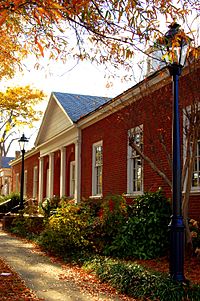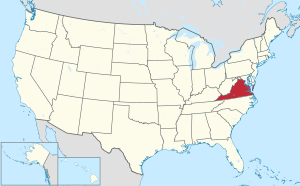Cumberland County, Virginia facts for kids
Quick facts for kids
Cumberland County
|
|||
|---|---|---|---|

Cumberland County Courthouse
|
|||
|
|||

Location within the U.S. state of Virginia
|
|||
 Virginia's location within the U.S. |
|||
| Country | |||
| State | |||
| Founded | 1749 | ||
| Named for | William Augustus, Duke of Cumberland | ||
| Seat | Cumberland | ||
| Largest town | Farmville | ||
| Area | |||
| • Total | 300 sq mi (800 km2) | ||
| • Land | 297 sq mi (770 km2) | ||
| • Water | 2.3 sq mi (6 km2) 0.8% | ||
| Population
(2020)
|
|||
| • Total | 9,675 | ||
| • Density | 32/sq mi (12.5/km2) | ||
| Time zone | UTC−5 (Eastern) | ||
| • Summer (DST) | UTC−4 (EDT) | ||
| Congressional district | 5th | ||
Cumberland County is a county located in the Commonwealth of Virginia, United States. As of the 2020 census, the population was 9,675. Its county seat is Cumberland.
Contents
History
Cumberland County was established in 1749 from Goochland County. The county is named for William Augustus, Duke of Cumberland, third son of King George II of Great Britain. Cumberland County was also home to the Fleming family, which included Judge John Fleming and his son Judge William Fleming.
From 1749 until 1777, when the eastern portion was detached to form Powhatan County, Mosby Tavern served as the county courthouse. The tavern subsequently became known as "Old Cumberland Courthouse." In 1778 the narrow triangular area bordering the southern bank of the James River was annexed from Buckingham County.
Geography
According to the U.S. Census Bureau, the county has a total area of 300 square miles (780 km2), of which 297 sq mi (770 km2) is land and 2.3 sq mi (6.0 km2) (0.8%) is water.
Adjacent counties
- Goochland County – northeast
- Powhatan County – east
- Amelia County – southeast
- Prince Edward County – south
- Buckingham County – west
- Fluvanna County – northwest
Major highways
 US 60
US 60 SR 13
SR 13 SR 45
SR 45
Demographics
This rural county suffered a long decline in population from 1880 to 1970, as the number of workers needed for agriculture was reduced through mechanization. Since then its population has grown, reaching a peak in 2010 nearly equal to its 19th-century high.
| Historical population | |||
|---|---|---|---|
| Census | Pop. | %± | |
| 1790 | 8,153 | — | |
| 1800 | 9,839 | 20.7% | |
| 1810 | 9,992 | 1.6% | |
| 1820 | 11,023 | 10.3% | |
| 1830 | 11,690 | 6.1% | |
| 1840 | 10,399 | −11.0% | |
| 1850 | 9,751 | −6.2% | |
| 1860 | 9,961 | 2.2% | |
| 1870 | 8,142 | −18.3% | |
| 1880 | 10,540 | 29.5% | |
| 1890 | 9,482 | −10.0% | |
| 1900 | 8,996 | −5.1% | |
| 1910 | 9,195 | 2.2% | |
| 1920 | 9,111 | −0.9% | |
| 1930 | 7,535 | −17.3% | |
| 1940 | 7,505 | −0.4% | |
| 1950 | 7,252 | −3.4% | |
| 1960 | 6,360 | −12.3% | |
| 1970 | 6,179 | −2.8% | |
| 1980 | 7,881 | 27.5% | |
| 1990 | 7,825 | −0.7% | |
| 2000 | 9,017 | 15.2% | |
| 2010 | 10,052 | 11.5% | |
| 2020 | 9,675 | −3.8% | |
| U.S. Decennial Census 1790-1960 1900-1990 1990-2000 2010 2020 |
|||
2020 census
| Race / Ethnicity (NH = Non-Hispanic) | Pop 2010 | Pop 2020 | % 2010 | % 2020 |
|---|---|---|---|---|
| White alone (NH) | 6,353 | 6,104 | 63.20% | 63.09% |
| Black or African American alone (NH) | 3,253 | 2,817 | 32.36% | 29.12% |
| Native American or Alaska Native alone (NH) | 36 | 39 | 0.36% | 0.40% |
| Asian alone (NH) | 35 | 36 | 0.35% | 0.37% |
| Pacific Islander alone (NH) | 0 | 8 | 0.00% | 0.08% |
| Some Other Race alone (NH) | 17 | 40 | 0.17% | 0.41% |
| Mixed Race or Multi-Racial (NH) | 177 | 390 | 1.76% | 4.03% |
| Hispanic or Latino (any race) | 181 | 241 | 1.80% | 2.49% |
| Total | 10,052 | 9,675 | 100.00% | 100.00% |
Education
Cumberland County Public Schools serves over 1400 students in the county. The district operates Cumberland Elementary School (PreK-4), Cumberland Middle School (5-8), and Cumberland High School (9-12). The superintendent is Dr. Chip Jones (2022).
Communities
Town
- Farmville (primarily in Prince Edward County)
Unincorporated communities
Attractions and events
Bear Creek Lake State Park is located 4.5 miles (7.2 km) northwest of the town of Cumberland. Bear Creek Lake features overnight cabins, a lodge, permanent camp sites, and picnic shelters. Swimming and boating are allowed at the lake, and boat rentals are available. The park also has trails for hiking and running.
The 16,233-acre (65.69 km2) Cumberland State Forest is north of U.S. Route 60, west of State Route 45 and bordered on the west by the Willis River. The Forest has multiple purposes, including watershed protection, recreation, timber production, hunting, fishing, and applied forest research. There are two self-guided trails at Cumberland State Forest that are open for walking, hiking, horses, and mountain bikes. These are the Cumberland Multi-Use Trail (14 miles) and the Willis River Hiking Trail (16 miles). White-tailed deer, wild turkey, and bobcats are common residents of this natural area. The State forest also features five lakes which may be fished from with a Virginia State fishing license, including: Oak Hill Lake, Bear Creek Lake, Winston Lake, Arrowhead Lake, and Bonbrook Lake.
Notable people
- Justice Paul Carrington (1733–1818), second member appointed of the Virginia Supreme Court. Born at "Boston Hill".
- Lena Trent Gordon (1885-1935), Philadelphia-based political organizer, poet, born in Cumberland.
See also
 In Spanish: Condado de Cumberland (Virginia) para niños
In Spanish: Condado de Cumberland (Virginia) para niños



